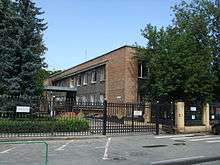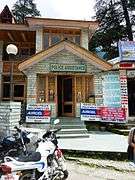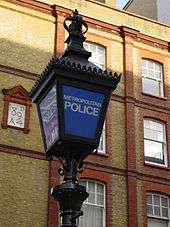Police station

Red sign outside a Swedish police station
A police station (sometimes called a "station house" in the US) is a building which serves to accommodate police officers and other members of staff. These buildings often contain offices and accommodation for personnel and vehicles, along with locker rooms, temporary holding cells and interview/interrogation rooms. In many countries, the commander of a police station is called a commissary.
Facilities
Large departments may have many stations to cover the area they serve. The names used for these facilities include:
- Area Commands are used by the Las Vegas Metropolitan Police Department.
- Barracks are used for many American state police and highway patrol stations.
- Detachment for local facilities of the Royal Canadian Mounted Police and the Ontario Provincial Police.
- District offices are used by the California Highway Patrol.
- Districts are used by some urban police departments such as the Denver, Baltimore, Milwaukee, Detroit, New Orleans, Chicago, St. Louis, Philadelphia, and District of Columbia police departments.
- Divisions are used by the Toronto Police Service, Los Angeles Police Department, Fort Worth Police Department, Houston Police Department, the London Metropolitan Police Service, and other urban police departments.
- Precinct or precinct house for regional facilities of the New York City Police Department, Memphis Police Department, Newark Police Department, and other urban police departments in the United States.
- Substations are used by many departments, especially county sheriffs.
- Zones are used by some urban police departments such as the Atlanta Police Department.
- Basic Command Units are used by most British police forces.
- Kōban are small neighborhood police offices in Japan.
- Polis karakolu are small neighborhood police stations in Turkey.
- Specialized stations, such as women's police stations in Latin America and elsewhere.
India
A police station in India is typically under the command of an Inspector. In the case of a police station which is the headquarters of a Police Circle, the Inspector's office is clearly demarcated (and most likely in a separate building)
United Kingdom
The county Constabularies in Great Britain were previously organised on a village basis. Most villages of any size had a "police house". Police houses in small villages were often staffed by a single uniformed Constable, with larger stations being staffed by more. Local police stations were grouped together under the command of a uniformed Sergeant, whose station was known as a "sergeant's station". Larger towns in the county constabulary areas had police stations staffed by a number of officers, often under the command of an inspector or superintendent, usually also commanding a sub-division or division respectively, and therefore giving the names of "sub-divisional station" or "divisional station" to their stations.
In Scotland a Police Station may be referred to as a Police Office.
Gallery
| An English police station: Wood Street station in Wakefield |
| Many British and Commonwealth police stations have a blue lamp outside. |
| Cells used in Leith Police Station between 1833 and 2003 |
| Police station in Patagonia (southern Chile). |
|
See also
References



